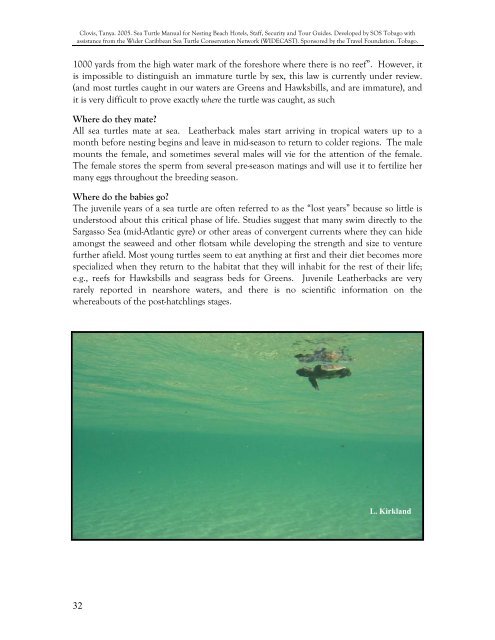Clovis, Tanya. - WIDECAST
Clovis, Tanya. - WIDECAST
Clovis, Tanya. - WIDECAST
You also want an ePaper? Increase the reach of your titles
YUMPU automatically turns print PDFs into web optimized ePapers that Google loves.
<strong>Clovis</strong>, <strong>Tanya</strong>. 2005. Sea Turtle Manual for Nesting Beach Hotels, Staff, Security and Tour Guides. Developed by SOS Tobago with<br />
assistance from the Wider Caribbean Sea Turtle Conservation Network (<strong>WIDECAST</strong>). Sponsored by the Travel Foundation. Tobago.<br />
1000 yards from the high water mark of the foreshore where there is no reef”. However, it<br />
is impossible to distinguish an immature turtle by sex, this law is currently under review.<br />
(and most turtles caught in our waters are Greens and Hawksbills, and are immature), and<br />
it is very difficult to prove exactly where the turtle was caught, as such<br />
Where do they mate<br />
All sea turtles mate at sea. Leatherback males start arriving in tropical waters up to a<br />
month before nesting begins and leave in mid-season to return to colder regions. The male<br />
mounts the female, and sometimes several males will vie for the attention of the female.<br />
The female stores the sperm from several pre-season matings and will use it to fertilize her<br />
many eggs throughout the breeding season.<br />
Where do the babies go<br />
The juvenile years of a sea turtle are often referred to as the “lost years” because so little is<br />
understood about this critical phase of life. Studies suggest that many swim directly to the<br />
Sargasso Sea (mid-Atlantic gyre) or other areas of convergent currents where they can hide<br />
amongst the seaweed and other flotsam while developing the strength and size to venture<br />
further afield. Most young turtles seem to eat anything at first and their diet becomes more<br />
specialized when they return to the habitat that they will inhabit for the rest of their life;<br />
e.g., reefs for Hawksbills and seagrass beds for Greens. Juvenile Leatherbacks are very<br />
rarely reported in nearshore waters, and there is no scientific information on the<br />
whereabouts of the post-hatchlings stages.<br />
L. Kirkland<br />
32
















